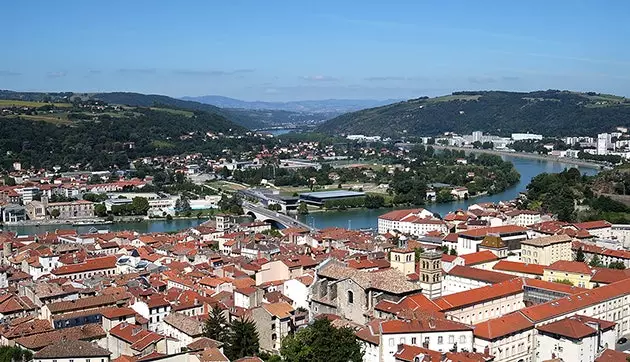
Come to Vienne, a treasure on the banks of the Rhône
TERRACE-TERRACE-ROMAN MONUMENT-TERRACE
The only concession Vienne gave to cars is the old dual carriageway that mars the views from the Rhône. Nothing more. And it is that this city, located just over 30 kilometers south of Lyon, it remains pedestrian, street and rogue territory. That is why, when you have the permission of His Lordship the Sun, the awnings and terraces flood the streets of a historic center with a grid layout but with anarchic, medieval and playful lines. And in this goofy, beer-filled walk, Roman remains suddenly appear.
The most scandalous is that of the Temple of Augustus and Livia, a prodigious silhouette that emerges in the heart of the old forum and is the true nerve center of the city. It is the classic Roman religious building, with those fibrous columns that not even King Kong would knock down, its neglected pediment and its pagan altar. The interior was defenestrated by the Church, who converted it into a church for centuries. The arrival of the 19th century and the anticlerical currents allowed its initial appearance to be recovered and any evangelizing remains to be eliminated. And his gallantry returned, his iconic magnetism and that disproportion that makes him a giant between the houses and roofs of the Place du Palaise Charles de Gaulle . This pilgrimage crosses the Françoise Mitterrand Square, the eastern limit of the old forum, and reaches the Cibeles Garden, an archaeological park in which the walls of the small auditorium, the floors of a considerably large domus and the ribs of a great arch that served as a jubilant entrance to the great Forum. And already sculpted in the mountains that protect the river, the monumental great theater appears, the jewel in the crown, one of those settings for posterity from where you can enjoy a romantic sunset and the joyful romp of the sun melting the roofs before saying goodbye. Here, during the summer, everything is… (see last point) .
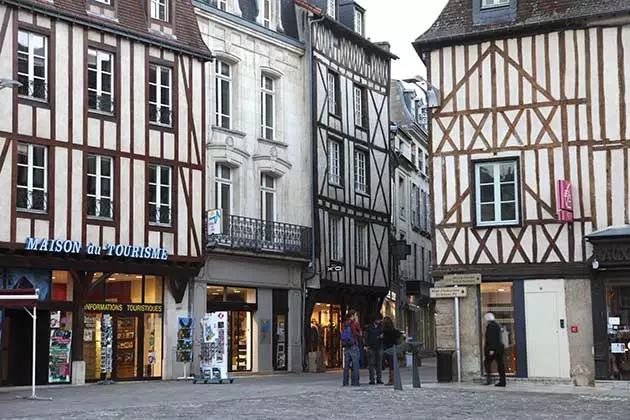
Place du Palaise Charles de Gaulle, mandatory stop
THE -PARADOXICALLY- MODERN ARCHAEOLOGICAL MUSEUM
So many Roman remains on the east bank of the Rhône are just a prelude to the great site. Just across the river appears Saint Romain-en-Gal and its Gallo-Roman museum . Or what is the same, what remains of the expansion of the city and domain (by bridge) of the valley and river trade. All condensed in a museum that, in 1996, surprised both locals and foreigners with its modern lines, its lighting and its way of exhibiting archaeological pieces. With this method, it manages to remove the dust and the yellowish whiff that these types of museums have and makes it attractive to all types of visitors. And yet the best is outside, as the metal buildings serve to protect the excavations and finds in a wide meadow. Apart from the classic roads and imagination exercises projecting buildings on nothing, the most outstanding are the latrines and their cleaning system. Eschatological tourism? Rather curious, surprising. The umpteenth sign that progress has helped to be intimate in 'those' moments. Even if it is at the cost of socializing less.
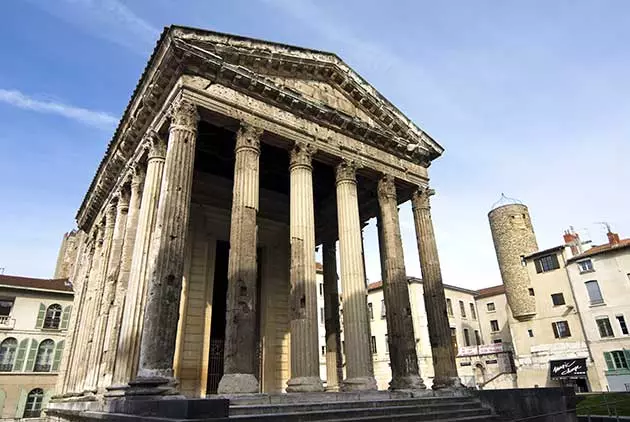
Temple d'Auguste and Livie
A PARADE OF BELLS
For the rest, the city is not deprived of churches. In its day it played an important role as a border between the Holy Roman Empire and old France, which gave it prestige as a city and bell towers of all styles. Of course there is no lack a lady gothic cathedral, dedicated to Saint Maurice with one of those facades that can be enjoyed from a low angle and that knows how to pose for photos. oh! And with a bombastic and colorful interior due to the stained glass windows. Quickly the view is surprised by the tower of the Saint-Pierre Church, one of the oldest in France (it has parts from the 5th century) whose maximum expansion occurred in the 12th century, when its Romanesque bell tower became the Vienne skyscraper. Today it is a surprising archaeological museum, very peculiar (because of its continent) and full of chiaroscuro, where the remains of Roman sculptures share a showcase with Catholic relics. Finally impresses, for its beauty and delicacy, the "lighthouse" of the abbey of Saint-André-le-Bas ; a piece of Tuscan Romanesque that steals all the prominence from this beautiful monastic complex.
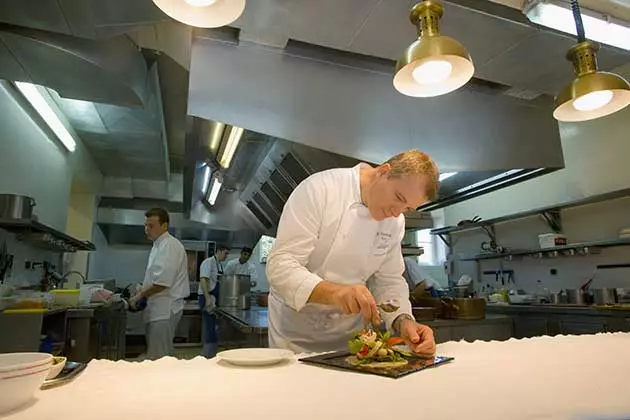
La Pyramide, a gastronomic benchmark
…AND GOD SAW THAT ‘THE PYRAMID’ WAS GOOD
If you continue with the search for Roman remains, you will reach the surprising Pyramid, the monument that was located in the center of the old Roman circus. It is the only thing that remains of him, but he is quite a symbol... foodie. And it is that 'La Pyramide' lent its name to the cradle of new French gastronomy, the restaurant of the pioneer , of the great Fernand Point, of the teacher of teachers. Not in vain is it the first restaurant to achieve three Michelin stars in 1933 and great chefs such as Paul Bocuse have cut their teeth in its kitchens. Today it is part of a very charming Relais & Chateaux in whose entrails gastronomy continues to shine thanks to its new boss, chef Patrick Henriux , who has maintained the level of the letter and that has resulted in two well-deserved stars. But in addition, the new wing stands out, a space for all pockets called PH3 where food is served at all hours of the day with a chauvinist and respectable philosophy: in case of doubt, products from the region. Result.
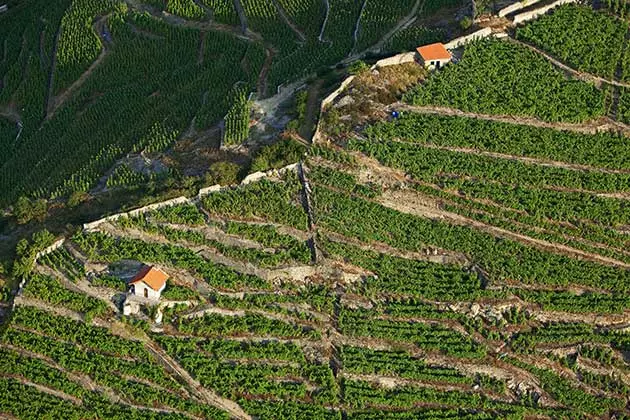
And the wines could not miss
“REACT WITH PATIENCE” IN CÔTE-RÔTIE
The intense relationship between Vienne and gastronomy is not only based on local products, but also on wine. And it is that Vienne, administratively, is the capital of Côte-Rôtie, one of the best wine regions on the banks of the Rhône. Here the wineries take it seriously, with wines of supreme quality thanks to a Sirah tamed and educated to be the femme-fatale of palates around the world. And with prices adjusted to the result and her fame. That's why, large wineries such as Guigal or Duclaux do not open their doors to the general public , because they do not need wine tourism, neither for branding nor for affiliation. Nevertheless, Corps de Loup has not resisted showing its Domaine , if only for the sheer pleasure of showing off these vineyards and showing off. The experience is very enriching. You begin by walking among the terraces on the slopes of the mountain, on land supported by stones that were moved by the Romans centuries ago. Then he goes into the bowels of the great house, where the wine is cured and the winemaking process is reviewed. And in the end, on the lovely porch that weaves among the old buildings, you can enjoy the tasting in a rural environment where only a small mural with a devastating phrase breaks with the liturgy: “React with patience”. Everything seems that simple in Côte-Rôtie.
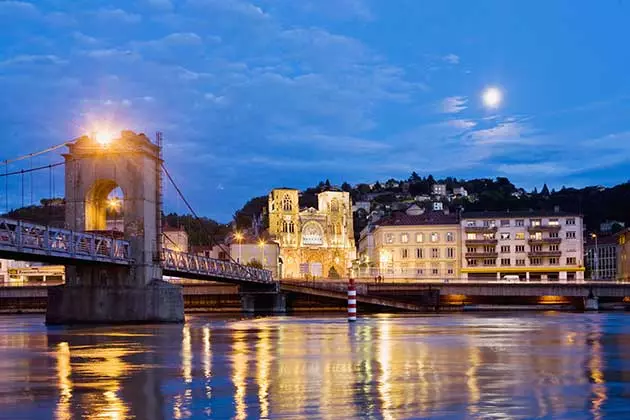
The cathedral of Vienne, a wonder
IN THE END, EVERYTHING IS JAZZ
But in the month of July the Romans, wine and gastronomy take a back seat. The city is infected with Jazz and the most monumental corners vibrate with trumpet solos and vocal improvisations. All of Vienne dances in the gardens and squares, where amateur and semi-professional musicians scratch the most sincere applause of the summer. Professionals meet on stages strategically located in the most emblematic corners. And of course, the epicenter is the great Roman Odeon, that theater with more than 13,000 spectators where Jazz afternoons are non-stop and people come with cathartic and metamorphic longings. The trance is not guaranteed. Good music, yes.
*** You may also be interested in...**
- 42 things you have to do in France once in your life
- Eleven curiosities you find when touring the west of France
- 10 things to learn in the French tarn
- Burgundy, the wine heart of France
- All articles by Javier Zori del Amo
